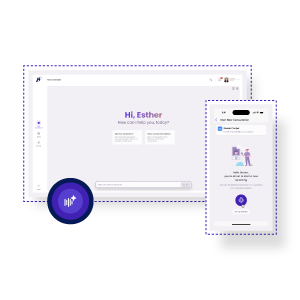They respond to questions. Set reminders. Take notes. But by the year 2025, voice assistants will be much more than weather tellers. They are revolutionizing care, silently in clinics, hospitals, and in the offices of private practice.
If you’re wondering what is AI voice assistant is, how it works, and whether it’s more than just a glorified smart speaker, you’re in the right place. So, to use health care as our example this time, let us take a step through the actual functions of these assistants and how and why they are needed now more than ever before.
What Is an AI Voice Assistant? The Principles, No Double-Talk
In simple terms, it is a voice-controlled computer device that listens, processes, and reacts to human speech by providing useful responses or actions. Ambient documentation considerably enhanced productivity (OR = 6.9) and reduced after-hours work (OR ≈ 4.95), according to a controlled survey of ambulatory doctors. Additionally, 48% of respondents reported being able to see more patients. However, new assistants take commands in conversations and even in a context, unlike previous tools of voice usage, which used inflexible commands. That in healthcare implies that they can:
- Carry out real-time recording of clinical discussions
- Formatted SOAP Notes of patient records
- Prompt billing or subsequent responses
- Log in without lifting a finger
Just imagine having a great digital co-pilot that sits in the background and works tirelessly, with there is no typing, no toggling.
Voice Assistant Examples in 2025: Beyond the Smart Speaker
We all know Alexa, Siri, or Google Assistant. But the voice assistant examples in changing healthcare are a little different. The following are some of the real-life examples within a medical practice:
HealthOrbit AI: Your Clinical Talking Pal
HealthOrbit AI monitors clinical discussions and generates live notes in your electronic medical record. It transports SOAP notes, keeps track of vital signs, and even assists with AI medical billing coding.
Smart Room Integration – No More Manual Entries
Some hospitals now use ambient voice assistants in exam rooms. Providers can say, “Log that as a follow-up for 3 months,” and it’s done. No clicks. No delays. Function? Here’s a simplified breakdown:
Speech Recognition
First, your spoken words are converted into text through real-time transcription. Modern voice engines can handle various accents, speeds, and even medical terminology.
Voice-Powered Rounding – Notes on the Move
Specialists making rounds can simply speak as they walk. Voice assistants transcribe and organize the updates instantly, syncing back to the central system.
These examples show how far we’ve come. Voice tech isn’t just consumer-focused—it’s embedded into medical workflows, saving hours of admin time.
How Does an AI Digital Assistant Work?
Understanding what AIvoice assistants also means, looking under the hood. So, how do these systems
Natural Language Processing (NLP)
Next, the system deciphers what you meant, not just what you said. It understands phrases like “next Thursday” or “double the dose” and turns them into structured data.
Learning from Use
Over time, your assistant improves. It adapts to your specialty, common diagnoses, and preferred workflows, making it more accurate every day.
When combined with ambient technology, this process becomes hands-free. You don’t need to prompt it. It listens, learns, and documents automatically.
What Makes HealthOrbit AI Assistant Different?
Not all assistants are made equal. Some were built for phones. Others were retrofitted into clinical settings. HealthOrbit AI was designed from day one to solve healthcare-specific problems.
Why It’s the Standout Choice?
- Captures AI clinical notes live during patient visits
- Structures SOAP Notes based on real-time speech
- Handles AI medical billing coding suggestions
- Seamless EHR integration
- Built with privacy, accuracy, and speed in mind
When you ask what is AI voice assistant is in a healthcare context, HealthOrbit AI is the practical answer. It works in the background, improves provider focus, and cuts down documentation time by hours each week.
Why Voice Assistants Are a Must-Have in Modern Practices?
Still wondering what is AI voice assistant is and whether it’s worth it? Let’s break down the benefits healthcare providers are seeing:
- Improved Accuracy: Voice capture reduces typos and missed details
- More Patient Time: Less screen staring, more connection
- Faster Documentation: SOAP Notes are written while you speak
- Billing Confidence: Smart coding suggestions reduce revenue loss
- Reduced Click Fatigue: No more bouncing between screens
And perhaps the biggest benefit of all? It brings joy back to practicing medicine.
Final Thoughts
We started by asking what is AI voice assistant is, and hopefully by now, it’s clear: it’s more than a convenience. It’s a clinical partner.
The right assistant captures everything you say (safely), structures it for compliance, and leaves you with less paperwork and more peace of mind. If your practice is drowning in documentation, this isn’t a trend—it’s the solution.
Ready to cut charting time and bring joy back to care? Book your demo with HealthOrbit AI today.
FAQs
What is an AI voice assistant in healthcare?
It’s a voice-powered tool that listens to clinical conversations and documents them in real time, often creating SOAP Notes, helping with billing, and reducing manual charting.
How is HealthOrbit AI different from general voice assistants?
Unlike consumer tools, HealthOrbit AI is built specifically for medical professionals. It understands clinical workflows, ambient documentation, and HIPAA-compliant data handling.
Can a voice assistant handle billing, too?
Yes. HealthOrbit AI assistant can flag billable procedures, support AI medical billing, and suggest accurate codes—all while capturing the patient visit.
Is ambient technology safe for use in clinical environments?
Absolutely. HealthOrbit AI uses encrypted, permission-based systems to ensure patient data is always protected.Where can I try HealthOrbit AI voice assistant?
Visit HealthOrbit.ai to request a demo and see it in action.




